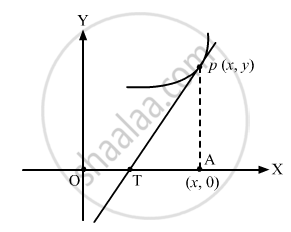Advertisements
Advertisements
प्रश्न
Find the equation of the curve which passes through the point (1, 2) and the distance between the foot of the ordinate of the point of contact and the point of intersection of the tangent with x-axis is twice the abscissa of the point of contact.
उत्तर

It is given that the distance between the foot of ordinate of point of contact (A) and point of intersection of tangent with x-axis (T) = 2x
\[\text{Coordinate of }T = \left( x - y\frac{dx}{dy}, 0 \right)\]
\[\Rightarrow y - 0 = \frac{dy}{dx}\left(x - \left( x - y \frac{dx}{dy} \right) \right)\]
\[\Rightarrow y \frac{dx}{dy} = 2x\]
\[\Rightarrow \int\frac{dx}{x} = 2\int\frac{dy}{y}\]
\[\Rightarrow \ln x = \ln y^2 + \ln c\]
\[x = c y^2 \]
\[\text{As the circle passes through }\left( 1, 2 \right).\]
\[1 = c \times 2^2 \]
\[ \Rightarrow c = \frac{1}{4}\]
\[ \Rightarrow 4x = y^2\]
APPEARS IN
संबंधित प्रश्न
Form the differential equation representing the family of ellipses having centre at the origin and foci on x-axis.
Show that y = AeBx is a solution of the differential equation
Differential equation \[\frac{d^2 y}{d x^2} - y = 0, y \left( 0 \right) = 2, y' \left( 0 \right) = 0\] Function y = ex + e−x
Differential equation \[\frac{d^2 y}{d x^2} - 3\frac{dy}{dx} + 2y = 0, y \left( 0 \right) = 1, y' \left( 0 \right) = 3\] Function y = ex + e2x
(1 − x2) dy + xy dx = xy2 dx
(1 + x) (1 + y2) dx + (1 + y) (1 + x2) dy = 0
In a culture the bacteria count is 100000. The number is increased by 10% in 2 hours. In how many hours will the count reach 200000, if the rate of growth of bacteria is proportional to the number present.
If y(x) is a solution of the different equation \[\left( \frac{2 + \sin x}{1 + y} \right)\frac{dy}{dx} = - \cos x\] and y(0) = 1, then find the value of y(π/2).
Solve the following initial value problem:-
\[\left( 1 + y^2 \right) dx + \left( x - e^{- \tan^{- 1} y} \right) dx = 0, y\left( 0 \right) = 0\]
Solve the following initial value problem:-
\[\frac{dy}{dx} + 2y \tan x = \sin x; y = 0\text{ when }x = \frac{\pi}{3}\]
The surface area of a balloon being inflated, changes at a rate proportional to time t. If initially its radius is 1 unit and after 3 seconds it is 2 units, find the radius after time t.
Find the equation of the curve which passes through the point (2, 2) and satisfies the differential equation
\[y - x\frac{dy}{dx} = y^2 + \frac{dy}{dx}\]
Find the equation to the curve satisfying x (x + 1) \[\frac{dy}{dx} - y\] = x (x + 1) and passing through (1, 0).
At every point on a curve the slope is the sum of the abscissa and the product of the ordinate and the abscissa, and the curve passes through (0, 1). Find the equation of the curve.
If sin x is an integrating factor of the differential equation \[\frac{dy}{dx} + Py = Q\], then write the value of P.
The differential equation satisfied by ax2 + by2 = 1 is
What is integrating factor of \[\frac{dy}{dx}\] + y sec x = tan x?
Choose the correct option from the given alternatives:
The solution of `1/"x" * "dy"/"dx" = tan^-1 "x"` is
In the following example, verify that the given function is a solution of the corresponding differential equation.
| Solution | D.E. |
| xy = log y + k | y' (1 - xy) = y2 |
Form the differential equation from the relation x2 + 4y2 = 4b2
Solve the following differential equation.
x2y dx − (x3 + y3 ) dy = 0
Select and write the correct alternative from the given option for the question
Bacterial increases at the rate proportional to the number present. If original number M doubles in 3 hours, then number of bacteria will be 4M in
For the differential equation, find the particular solution
`("d"y)/("d"x)` = (4x +y + 1), when y = 1, x = 0
The solution of differential equation `x^2 ("d"^2y)/("d"x^2)` = 1 is ______
Given that `"dy"/"dx" = "e"^-2x` and y = 0 when x = 5. Find the value of x when y = 3.
Solve the differential equation `"dy"/"dx"` = 1 + x + y2 + xy2, when y = 0, x = 0.
The value of `dy/dx` if y = |x – 1| + |x – 4| at x = 3 is ______.
